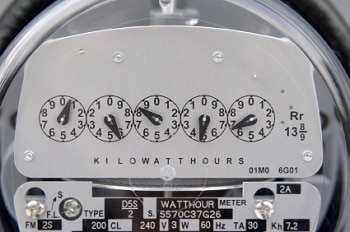How to Read Your Electricity and Natural Gas Meters

It’s easy to read electricity and natural gas meters, but there’s often a difference in how you read them. Whether you’re double-checking the numbers on a utility bill or you’re simply curious about the amount of electricity you’re using: here are a few tips to help you read your meters.
Reading Electricity Meters
Common electricity meters are clock-like devices that measure the amount of kilowatts of electricity that you use. If you use a thousand watts of electricity in one hour, then youve used one kilowatt-hour (kWh). When youre billed, youre charged for the number of kilowatt-hours that you use during a billing cycle.
There are five dials on an electricity meter that go from zero to nine. As you use electricity, the dials spin like the hands of a clock; the more electricity you use, the faster the dials spin. Dials one, three and five spin clockwise, while dials two and four spin counter clockwise. When you read the meter, you need to read the dials right-to-left (starting with dial five and moving to dial one), just like you would a car odometer. When the right-most dial passes zero, the dial to the left increases by one, and so on down the line to the left-most dial.
The result of your reading will be a five-digit number and the difference between two readings is the number of kilowatt-hours youve used.
When youre reading the meter and one of the dials is directly on a number, youll need to use either the number the dial sits on or the next lower number. To determine which one you need to use, look at the dial to the right. If it has passed zero, use the number the dial in question sits on. If the dial is directly on six, for example, and the dial to its right is on nine, you would record a five. If the dial to the right it hasnt passed zero, use the next lowest number. For example, if the dial is on six, but the dial to the right is on two, you would record a six. If a dial falls between two numbers, use the lower number.
Reading Natural Gas Meters
Typical natural gas meters look a lot like electricity meters but with only four dials (some can have up to six). Dials one and three spin counter clockwise, while dials two and four spin clockwise. The dials spin from the force of the moving gas in the pipe and spin faster as the flow increases. Depending on your utility, you can be billed by the thousands of cubic feet (MCF) or hundreds of cubic feet (CCF) of natural gas that you use. You could also be charged by the Therm, which is about the same as one CCF.
The difference between an electric meter and a natural gas meter is that you read natural gas meters left-to-right, starting with dial one and moving to dial four. When the left-most dial passes zero, the dial to the right increases by one, and so on down the line to the right-most dial. When a dial is directly over a number, consult the dial to the left to determine if you should use that number or next lowest number.
The result of your reading will be a four-digit number and the difference between two readings is usually the number of cubic feet of natural gas youve used.
Reading Digital Meters
Many electricity and natural gas customers are getting digital meters or Smart Meters installed by their utilities. Digital meters are the simplest to read. They work just like a car odometer and display an easy-to-read number. The difference between two readings is the amount of electricity or natural gas that youve used.
Sources
Public Utilities Commission of Ohio, Reading Your Natural Gas Meter.
U.S. Department of Energy, Energy Efficiency & Renewable Energy, How to Read Residential Electric and Natural Gas Meters.



